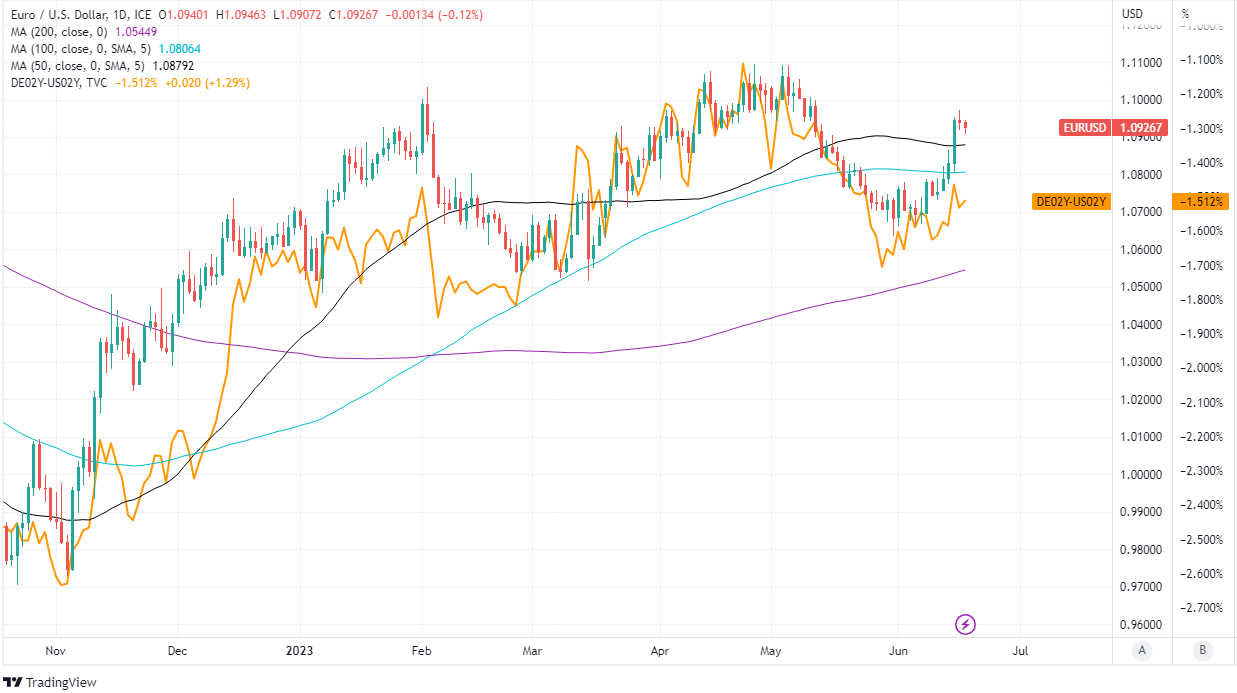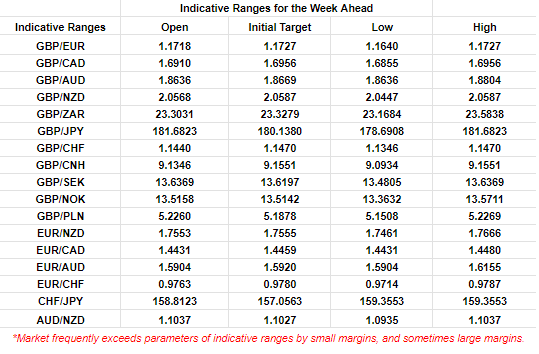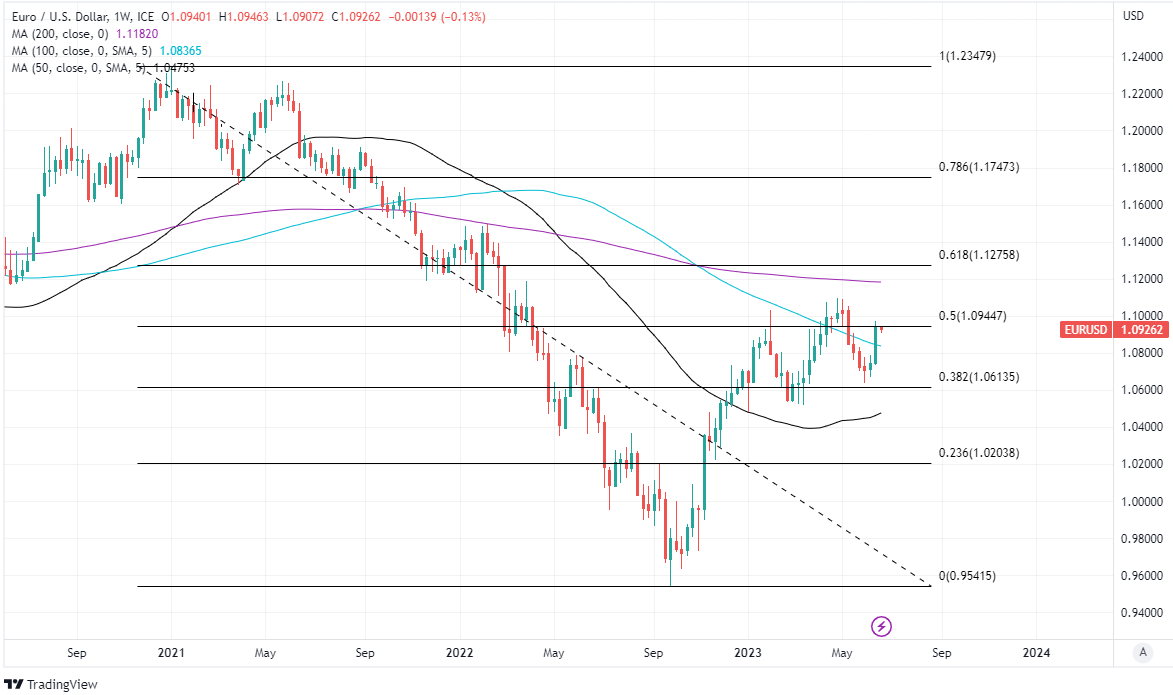EUR/USD Week Ahead Forecast: At Risk of Retracement to 1.08 or Below
- EUR/USD rally halted near resistance at 1.0944 on charts
- Risk of corrective retracement as far as 1.07 in short-term
- Technical support possible near & around 1.0806, 1.0879
- Europe PMIs, China stimulus chatter, Fed speak in focus

Commerzbank HQ looms over the Frankfurt skyline. Image © Andre Douque, reproduced under CC licensing conditions
The Euro to Dollar exchange rate pared away May losses in last week's trade but the rally has already stalled near a stubborn level of technical resistance on the charts while a retracement of recent global market gains and other factors could yet see the single currency slipping back toward 1.08 over the coming days.
Europe's single currency notched its largest gain of the year last week as financial markets responded to a less bleak economic growth outlook from the European Central Bank (ECB) and possibly also its openness to further increases in Euro Area interest rates over the coming months.
"Lagarde’s comments has encouraged the OIS market to price two more 25bp increases in the ECB’s policy interest rates," says Carol Kong, an economist and currency strategist at Commonwealth Bank of Australia.
"Also supporting EUR is an improvement in Europe’s current account position because of low energy prices. But we expect EUR/USD to remain below the May 2023 high of 1.1095," Kong writes in Monday market commentary.
Above: Euro to Dollar rate shown at daily intervals with selected moving averages denoting possible areas of technical support and/or resistance for the single currency, and featured alongside the spread or gap (thick orange line) between 02-year German and U.S. government bond yields.
The Euro and others appeared to benefit as the Dollar was pulled lower last week after the Peoples' Bank of China cut its interest rate amid market and media speculation about a potentially large government stimulus to revive the country's flagging economic recovery being on the way.
But the rub or risk for the single currency is that at least some of the recent tailwinds either become or remain as dampening headwinds this week and lead the Euro-Dollar rate to deflate back to levels that would be more closely aligned with the differential between German and U.S. government bond yields: somewhere near the 1.07 level.
That scenario would be particularly likely if S&P Global surveys of the European manufacturing and services sectors underwhelm economist expectations on Friday, or if the Dollar is cheered on Wednesday or Thursday by interest rate related congressional testimonies from Federal Reserve Chairman (Fed) Jerome Powell.
"Consumer-facing services will dampen the downturn caused by Fed rate hikes in the US and prevent European economies from falling into a genuine recession, despite some headwinds for global trade, an inventory correction in manufacturing and a plunge in residential construction," says Holger Schmieding, chief economist at Berenberg.
Above: Quantitative model estimates of ranges for this week. Source Pound Sterling Live.
"More balanced growth with a return of many consumer-facing services to their longer-run trends is good. But as European Central Bank President Christine Lagarde pointed out on Thursday, consumer-facing services tend to be labour intensive," he adds in a Monday research briefing.
All eyes will be on the European services sector on Friday in order to gauge whether this year's recovery in activity indicators persisted through June as this would raise the risk of positive real or inflation-adjusted wage growth that could have implications for ECB inflation forecasts further down the line.
"Wage pressures, while partly reflecting one-off payments, are becoming an increasingly important source of inflation. Compensation per employee rose by 5.2 per cent in the first quarter of the year and negotiated wages by 4.3 per cent," President Christine Lagarde said at last Thursday's press conference.
"Moreover, firms in some sectors have been able to keep profits relatively high, especially where demand has outstripped supply. Although most measures of longer-term inflation expectations currently stand at around 2 per cent, some indicators remain elevated and need to be monitored closely," she added.
Above: Euro to Dollar rate shown at weekly intervals with Fibonacci retracements of 2021 downtrend indicating possible areas of technical resistance for single currency while selected moving averages denote possible areas of support and/or resistance.
European wage increases was just 0.1% shy in the first quarter of the 5.3% core inflation rate recorded for June, suggesting parts of the economy are catching up fast with the inflation seen over recent years, while last week's upgrades to the ECB's economic growth forecasts suggest this could be sustained for a little longer in Europe.
But that prospect, pricing of the outlook for ECB interest rates and the Euro might all be sensitive to any signs of moderating momentum in services while in the interim a falling Renminbi would be a risk for EUR/USD if the mooted stimulus in China either does not materialise or is instead concentrated on stimulating domestic production.
"There have been unconfirmed reports that China is working on targeted measures to support the property market," says Wee-Khoon Chong, a senior APAC market strategist at BNY Mellon, in Monday market commentary.
"Other sectors in focus include electric vehicles, along with increased financial support for advanced manufacturing and efforts to facilitate China's high-level technological self-reliance and independence," he adds.



